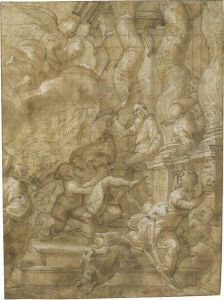Andrea Giovanni Ansaldo Paintings
Andrea Giovanni Ansaldo was a prominent Italian painter of the late Renaissance and early Baroque periods, born in 1584 in Voltri, now part of the modern city of Genoa. His artistic journey is emblematic of the transition in Italian art from the Mannerist style, characterized by artificiality and elongation of figures, to the more naturalistic and emotionally resonant Baroque. Ansaldo is often associated with the Genoese School of painting, which flourished in the late 16th and early 17th centuries, and his works are notable for their vibrant color, dynamic compositions, and a certain lyrical quality that distinguishes him from his contemporaries.
Ansaldo received his initial training in the workshop of Orazio Cambiaso, the son of the famous Luca Cambiaso, who was a leading figure in Genoese art. This early education grounded Ansaldo in the fundamentals of drawing and the Mannerist tradition. However, as his style evolved, it became evident that Ansaldo was also absorbing influences from the broader Italian art scene, particularly the naturalism of Caravaggio and the dynamic compositions of the Carracci family in Bologna. Despite these influences, Ansaldo developed a distinct style that balanced the idealization of the Renaissance with the emerging Baroque sensibility for drama and emotion.
Throughout his career, Ansaldo was highly regarded for his frescoes and altarpieces. Among his most significant works is the fresco decoration of the dome of the Annunziata del Vastato in Genoa, which is considered a masterpiece of Genoese Baroque architecture and art. The frescoes exhibit Ansaldo's skill in creating an illusion of three-dimensional space on a curved surface, a hallmark of Baroque art. His altarpieces, often depicting scenes from the life of the Virgin Mary and other religious subjects, are admired for their emotional depth and the interplay of light and shadow, which adds a dramatic intensity to the narratives.
Ansaldo's contributions to the Genoese School and Italian art as a whole were significant. Through his works, he bridged the gap between the late Renaissance and Baroque, influencing a generation of artists in Genoa and beyond. His legacy is a testament to the vibrancy and dynamism of early 17th-century Italian art, and his paintings continue to be studied and admired for their beauty and emotional power. Andrea Giovanni Ansaldo died in 1638 in Genoa, leaving behind a body of work that remains an important part of Italy's cultural heritage.






